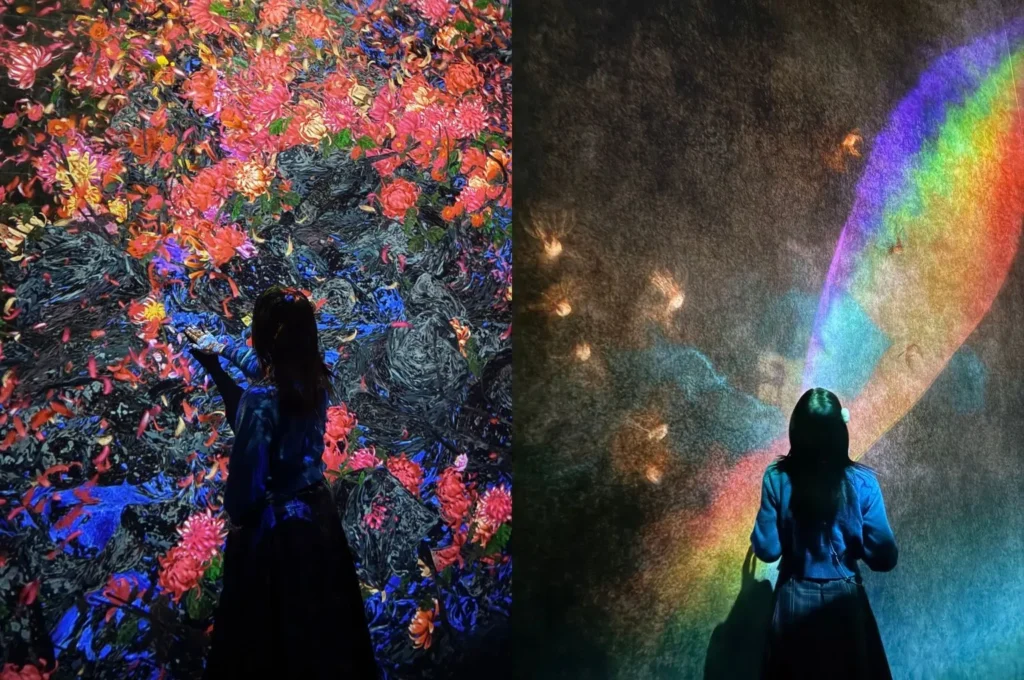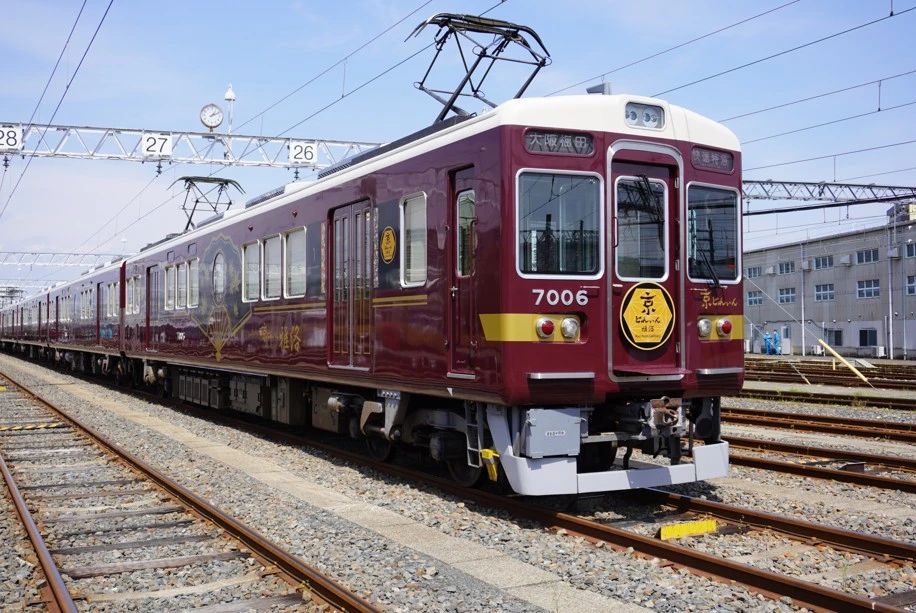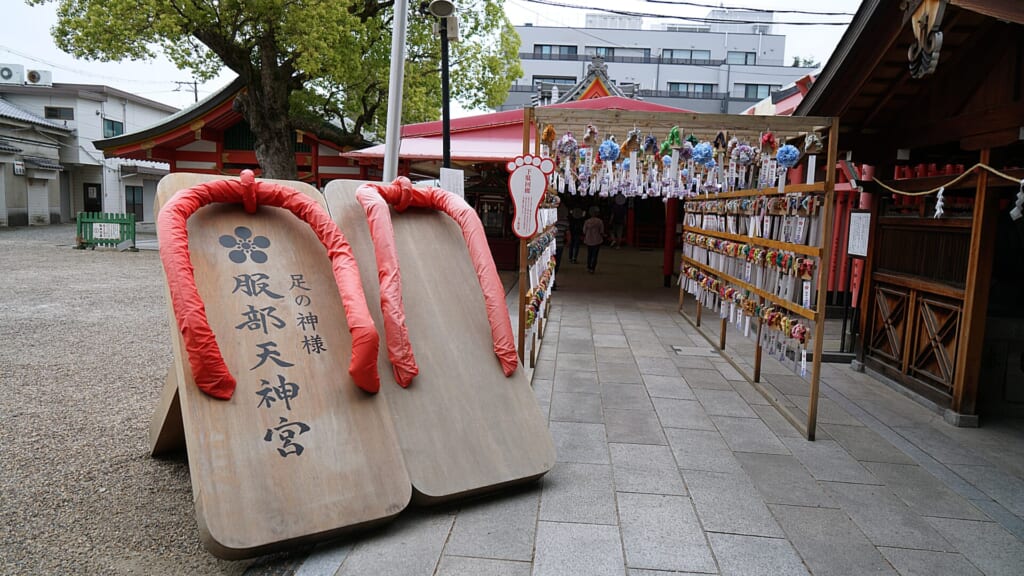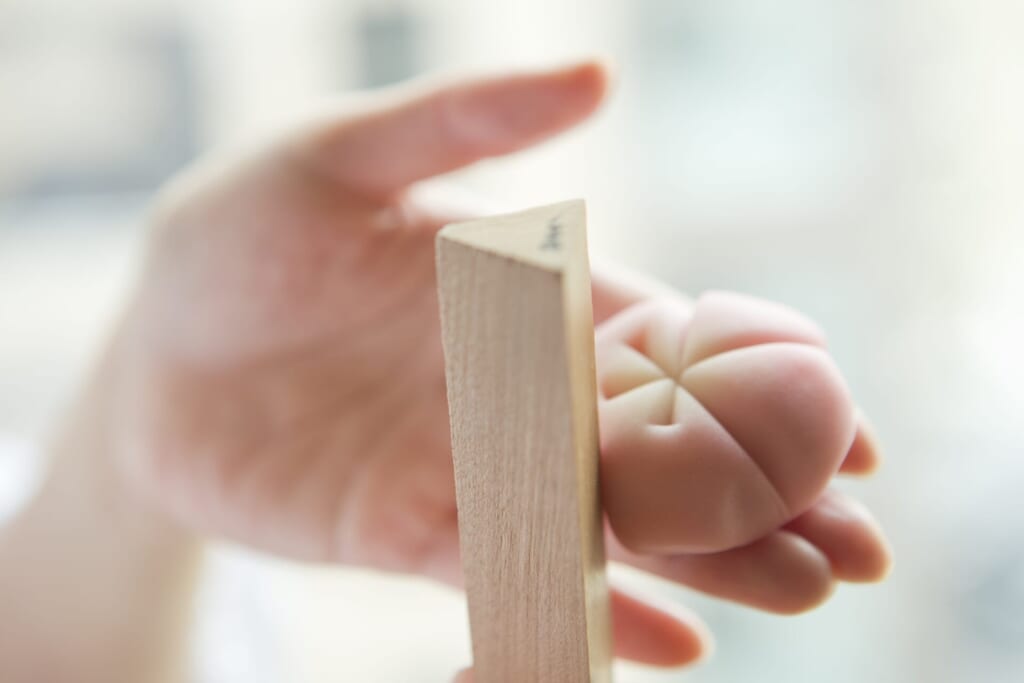เกียวโต
เกียวโตจะพาคุณไปสัมผัสกับ “จิตวิญญาณของญี่ปุ่น” สวมชุดกิโมโนแบบดั้งเดิมระหว่างที่เดินทางสำรวจวัดและศาลเจ้าเก่าแก่ในเมือง พร้อมลิ้มลองอาหารสไตล์ญี่ปุ่นที่คุณภาพดีและมีชื่อเสียง
บทความที่เกี่ยวข้อง
-

คู่มือเที่ยว teamLab Biovortex Kyoto: ตั๋วเข้าชม รีวิว และไฮไลท์ที่ห้ามพลาด
เตรียมพบกับวิวัฒนาการขั้นต่อไปของศิลปะดิจิทัล! teamLab Biovortex Kyoto เปิดตัวอย่างเป็นทางการแล้ว โดยถือเป็นนิทรรศการที่ใหญ่ที่สุดในญี่ปุ่นของกลุ่มศิลปินชื่อดังระดับโลก หากคุณวางแผนเดินทางไปภูมิภาคคันไซ นี่คือ teamLab แห่งใหม่ในเกียวโตที่คุณไม่ควรพลาดอย่างเด็ดขาด ไม่ว่าคุณจะกำลังมองหาผลงานศิลปะที่ถ่ายรูปสวยๆ ลง Instagram หรือวางแผนการเยี่ยมชมที่ราบรื่นไร้ปัญหา บทความนี้ครอบคลุมทุกอย่างตั้งแต่ตั๋วเข้าชม teamLab Kyoto และเวลาเปิดทำการ ไปจนถึงผลงานศิลปะที่ห้ามพลาด -สารบัญ- 1. ทำไม teamLab Biovortex Kyoto ถึงเป็นสถานที่ที่ไม่ควรพลาด 2. สถานที่ตั้ง เวลาเปิดทำการ และตั๋วสำหรับ teamLab Biovortex Kyoto – สถานที่ตั้งและการเดินทาง – วันและเวลาเปิดทำการ – ตั๋วและการจองออนไลน์ 3. เคล็ดลับก่อนเข้าชม teamLab Biovortex Kyoto 4. รีวิวแต่ละชั้น: จุดถ่ายรูปที่ดีที่สุดใน teamLab Biovortex Kyoto – A. ชั้นใต้ดิน: ความงดงามเหนือจริง – B. ชั้นประติมากรรมและภาพวาด: สัมผัสศิลปะด้วยร่างกายทั้งหมดของคุณ – C. ชั้นเมกะลิธ: ประติมากรรมแสงสูงตระหง่าน – D. ป่ากีฬาและสวนแห่งอนาคต: สนุกสนานและมีปฏิสัมพันธ์ 5. ปรับแต่งงานศิลปะของคุณเองได้ที่ร้านขายของที่ระลึก Sketch Factory 6. เกียวโต vs. โอซาก้า: เปรียบเทียบกับ teamLab Botanical Garden Osaka teamLab Biovortex Kyoto พิพิธภัณฑ์ถาวรขนาดใหญ่แห่งใหม่ที่เปิดเมื่อวันที่ 7 ตุลาคม 2025 ได้กลายเป็นนิทรรศการ teamLab ที่ใหญ่ที่สุดในญี่ปุ่น แนวคิด “Biovortex” อันเป็นเอกลักษณ์ของที่นี่สำรวจความเชื่อมโยงของชีวิต ที่ซึ่งการปรากฏตัวของคุณและการกระทำของผู้อื่นส่งผลกระทบและกำหนดรูปแบบงานศิลปะดิจิทัลที่เปลี่ยนแปลงอยู่ตลอดเวลา ต่อไปนี้เป็นข้อมูลสำคัญทั้งหมดก่อนเข้าชม teamLab Biovortex Kyoto รวมถึงวิธีการเดินทาง วันปิดทำการ และวิธีการซื้อตั๋ว teamLab Kyoto เดินทางสะดวก ทำให้เป็นสถานที่ที่เหมาะสำหรับเพิ่มลงในแผนการท่องเที่ยวเกียวโตของคุณ หากเดินทางโดยรถไฟ สถานีที่ใกล้ที่สุดคือสถานี JR Kyoto อย่าลืมออกจากทางออก Hachijo (ทางออกทิศใต้) จากนั้นคุณจะเดินถึงได้ภายใน 7 นาที ขอแนะนำให้จองตั๋วออนไลน์ล่วงหน้าเพื่อรับประกันการเข้าชม เนื่องจากตั๋วมักจะขายหมด โดยเฉพาะช่วงสุดสัปดาห์และวันหยุด หากตั๋วขายหมดแล้วทางออนไลน์ จะไม่สามารถซื้อได้ที่หน้างานเช่นกัน ประเภทตั๋วและส่วนลด มีตั๋ว 2 ประเภท คือ บัตรเข้าชมแบบปกติ และบัตรเข้าชมแบบยืดหยุ่น คุณสามารถซื้อบัตรได้จากเว็บไซต์อย่างเป็นทางการหรือ Klook ตารางต่อไปนี้เป็นการเปรียบเทียบตั๋วทั้งสองประเภท ประเภทตั๋ว ความแตกต่างหลัก ราคา ส่วนลด บัตรเข้าชมแบบปกติ ต้องเลือกช่วงเวลาและวันที่ที่ต้องการ อายุ 18 ปีขึ้นไป: 3,600 เยน~ อายุ 13 – 17 ปี: 2,800 เยน อายุ 4 – 12 ปี: 1,800 เยน อายุ 3 ปีลงมา: ฟรี มีบริการสำหรับผู้พิการ บัตร Flexible Pass เพียงแค่เลือกวันที่เข้าชม คุณสามารถเข้าชมได้ตลอดเวลาทำการในวันที่เข้าชม 12,000 เยน ไม่มี นอกจากตั๋วเที่ยวเดียวแล้ว สำหรับผู้ที่ต้องการตั๋วเที่ยวเดียวไป/กลับสนามบินนานาชาติคันไซโดยรถไฟ JR Haruka ยังมีชุดตั๋วคอมโบให้บริการ ▶รายละเอียดเพิ่มเติมเกี่ยวกับชุดตั๋วคอมโบ JR Haruka ก่อนไปที่ teamLab Kyoto โปรดตรวจสอบเคล็ดลับต่อไปนี้เพื่อรับประกันการเข้าชมที่ราบรื่นและได้ภาพถ่ายที่สมบูรณ์แบบ ระยะเวลาที่แนะนำ: อย่างน้อย 2.5 ถึง 3 ชั่วโมง หากคุณต้องการสำรวจผลงานทั้งหมดกว่า 50 ชิ้นและเก็บภาพความทรงจำอันล้ำค่า เสื้อผ้าและรองเท้า: สวมใส่เสื้อผ้าสีเดียว โดยเฉพาะสีขาวหรือสีอ่อน แสงจากงานศิลปะจัดแสดงสะท้อนกับสีสันต่างๆ ทำให้คุณดูเปล่งประกายและโดดเด่นในทุกภาพถ่าย รองเท้าส้นแบนหุ้มส้นเป็นสิ่งจำเป็น! เพื่อความปลอดภัย รองเท้าส้นสูง รองเท้าแตะ หรือรองเท้าที่ไม่มั่นคงอื่นๆ จะไม่ได้รับอนุญาตให้เข้าพื้นที่กีฬา สำหรับผู้ที่ลืมเอามา มีรองเท้าผ้าใบให้เช่าอยู่ก่อนถึงพื้นที่กีฬา ที่เก็บของและกฎระเบียบ: มีล็อกเกอร์ฟรีสำหรับกระเป๋าขนาดเล็ก/เป้สะพายหลัง ไม่อนุญาตให้นำอาหารหรือเครื่องดื่มเข้าไปข้างใน ดังนั้นโปรดเก็บไว้ในล็อกเกอร์ด้วย ไม่อนุญาตให้นำรถเข็นเด็กเข้าไป ดังนั้นโปรดใช้ล็อกเกอร์แบบโซ่ที่อยู่ด้านข้าง โปรดทราบว่ามีล็อกเกอร์แบบโซ่สำหรับกระเป๋าเดินทางขนาดใหญ่เพียงไม่กี่ตู้เท่านั้น เตรียมกล้องของคุณให้พร้อม! นี่คืองานศิลปะที่น่าหลงใหลและถ่ายรูปสวยที่สุดใน teamLab Kyoto: ที่ชั้นใต้ดิน คุณจะได้เห็นสิ่งมหัศจรรย์ใหม่ๆ ที่ไม่เคยเห็นมาก่อนของแนวคิด “Biovortex” พื้นที่แรกที่คุณเดินเข้าไปเมื่อการเดินทางของ teamLab เริ่มต้นอย่างเป็นทางการคือห้องดอกไม้ที่กำลังบานและเหี่ยวเฉา เมื่อผู้คนสัมผัสดอกไม้ ดอกไม้ก็จะกระจัดกระจาย เมื่อคุณยืนนิ่ง ดอกไม้ที่อยู่ใกล้คุณจะเบ่งบานอย่างงดงามยิ่งขึ้น ที่นี่ คุณจะสัมผัสได้ถึงการไหลเวียนของเวลา อวกาศ และชีวิตอย่างแท้จริง เมื่อคุณหยุดอยู่หน้ากำแพงและถูกล้อมรอบด้วยดอกไม้ พวกมันจะกระจายตัวออกไปราวกับเวทมนตร์เมื่อคุณสัมผัสเบาๆ ด้วยปลายนิ้ว “ป่าแห่งโคมไฟก้องกังวาน” ประกอบด้วยโคมไฟนับไม่ถ้วน เมื่อมีคนหยุดอยู่ใกล้ๆ โคมไฟที่อยู่ใกล้ที่สุดจะส่องสว่าง และแสงนั้นจะไหลไปยังโคมไฟดวงถัดไปอย่างต่อเนื่อง โคมไฟจะเปลี่ยนสี ดังนั้นรอชมการแสดงแสงสีที่สมบูรณ์แบบ! ขึ้นไปชั้นบน ไฮไลท์คือการเปิดตัวครั้งแรกในญี่ปุ่นของ “ประติมากรรมไร้รูปร่าง” งานศิลปะชิ้นนี้มีลักษณะคล้ายฟองสบู่ที่ลอยอยู่ในอากาศราวกับก้อนเมฆ เพื่อปกป้องดวงตาและเสื้อผ้าของคุณ มีเสื้อกันฝน ที่คลุมรองเท้า และแว่นตาให้เช่า ถัดไปใน “ชีวิตนามธรรมชั่วคราวและการกลับคืน” คุณต้องเปลี่ยนเป็นรองเท้าบูทที่จัดเตรียมไว้ให้และก้าวเข้าไปในพื้นที่ของเหลว ของเหลวใต้ฝ่าเท้าของคุณจะบิดและเปลี่ยนแปลงไปในทุกย่างก้าว สร้างงานศิลปะนามธรรมที่แตกต่างและไม่เหมือนใครในทุกๆ เฟรม—มันน่าทึ่งมาก เดินขึ้นไปต่อ คุณจะมาถึงชั้นเมกะลิธ และทันทีที่เข้าไป คุณจะรู้สึกราวกับว่าถูกส่งไปยังอีกดาวเคราะห์หนึ่ง แม้แต่พืชพรรณที่นี่ก็ดูสมจริงและมีชีวิตชีวา โดยมีการรดน้ำเป็นครั้งคราว “จุลจักรวาลที่ก้องกังวาน – แสงที่แข็งตัว” จะหมุนเวียนไปตามสีต่างๆ 32 สี เมื่อคุณกดลูกบอลแสงเบาๆ พวกมันจะแกว่งไปมาเหมือนลูกแก้ว เข้าไปใกล้ๆ และโพสท่ากับลูกบอลหลากสีสันเหล่านี้เพื่อถ่ายรูปสวยๆ พื้นที่สุดท้ายคือสนามเด็กเล่นที่ทั้งผู้ใหญ่และเด็กสามารถสนุกสนานได้อย่างเต็มที่ มี “มินิเกม” หลากหลายรูปแบบที่ออกแบบมาเพื่อให้ร่างกายของคุณได้เคลื่อนไหวและมีส่วนร่วมอย่างเต็มที่ แต่โปรดทราบ: หากคุณสวมรองเท้าส้นสูงหรือรองเท้าแตะ โปรดเปลี่ยนเป็นรองเท้าผ้าใบก่อนเข้าพื้นที่นี้! การปีนป่ายกลางอากาศท่ามกลางฝูงนกหลากสีสันนั้นเหมาะสำหรับการถ่ายภาพแอ็คชั่นและแสดงให้เห็นถึงมิติที่หลากหลายของงานศิลปะ ในสวนสาธารณะแห่งอนาคตที่อยู่ติดกัน มี “มหาสมุทร” ขนาดใหญ่ อย่าลืมหยิบดินสอสีและวาดสัตว์ทะเลของคุณเอง! หลังจากที่พนักงานสแกนภาพวาดของคุณแล้ว คุณจะได้เห็นผลงานสร้างสรรค์ที่ไม่เหมือนใครของคุณโลดแล่นอยู่บนหน้าจอขนาดใหญ่ Sketch Factory คือที่ที่ศิลปะมาบรรจบกับของที่ระลึก! หลังจากได้เห็นสิ่งมีชีวิตของคุณมีชีวิตขึ้นมาในโลกดิจิทัล (จาก Graffiti Nature หรือ Sketch Ocean) คุณสามารถนำพวกมันกลับบ้านในโลกแห่งความเป็นจริงได้ ของที่ระลึกแบบกำหนดเอง: คุณสามารถพิมพ์ภาพวาดของคุณเองลงบนเสื้อยืด กระเป๋าผ้า หรือแม่เหล็ก ซึ่งเป็นของที่ระลึกส่วนตัวที่สมบูรณ์แบบสำหรับการผจญภัย teamLab Kyoto ของคุณ! หากคุณกำลังเดินทางผ่านภูมิภาคคันไซ คุณอาจสงสัยเกี่ยวกับสถานที่ยอดนิยมอีกแห่งหนึ่ง นั่นคือ สวนพฤกษศาสตร์นากาอิ ในโอซาก้า สถานที่/บรรยากาศ ความคิดเห็นที่ตรงไปตรงมา teamLab Biovortex Kyoto ใหญ่โต ในร่ม ไฮเทค มีแนวคิดที่ลึกซึ้ง และหลากหลาย เหมาะสำหรับผู้มาเยือนครั้งแรก! มีการติดตั้งที่หลากหลายกว่ามาก และเป็นกิจกรรมขนาดใหญ่ทั้งกลางวันและกลางคืน ให้ฉากหลังสำหรับการถ่ายภาพที่หลากหลายที่สุด teamLab Botanical Garden Osaka (สวนพฤกษศาสตร์นากาอิ) กลางแจ้ง ผสานธรรมชาติ ประสบการณ์ยามค่ำคืนในสวนสาธารณะ สวยงามและเงียบสงบ แต่เน้นการผสมผสานศิลปะเข้ากับธรรมชาติ เป็นสถานที่เสริมที่ยอดเยี่ยมหากคุณมีเวลา แต่เกียวโตคือไฮไลท์หลัก ▼สำหรับรายละเอียดเพิ่มเติม▼ ไฮไลท์และกิจกรรมน่าสนใจที่สวนพฤกษศาสตร์ teamLab Osaka teamLab Biovortex Kyoto ไม่ใช่แค่การชื่นชมศิลปะ แต่เป็นประสบการณ์ที่คุณจะได้เป็นส่วนหนึ่งของงานศิลปะ หลังจากดื่มด่ำกับประวัติศาสตร์และวัฒนธรรมของเกียวโตโบราณแล้ว อย่าลืมดำดิ่งสู่โลกดิจิทัลล้ำสมัยนี้ ความรู้สึกอันลึกซึ้งของการถูกโอบล้อมด้วยกระแสน้ำวนแห่งแสงและชีวิตจะเป็นไฮไลท์ที่น่าประทับใจที่สุดของการเดินทางของคุณ จองตั๋วของคุณล่วงหน้าและเพลิดเพลินไปกับการผจญภัย teamLab Kyoto ที่ยากจะลืมเลือน!
-

7 สุดยอดออนเซ็น ใกล้โอซาก้า
Onsen, or hot spring, is definitely one thing that you need to experience in Japan! If you have limited time but are eager to enjoy the unique atmosphere of a hot spring town, spend a night at an onsen inn, or combine sightseeing with a quick visit to a hot spring, we have selected some of the best hot springs and onsen towns near Osaka. Check the following recommendations as inspiration for planning your trip! Index Onsen etiquette: Everything you need to know about hot spring One of the best Japanese onsen towns near Osaka & Kyoto: Arima Onsen Coastal delights and hot spring town near Osaka: Kinosaki Onsen Hidden gem for hot spring enthusiasts: Takedao Onsen Koyokan Bettei Azalee Natural hot springs with private bath options in center Osaka: Solaniwa Onsen Can also visit Minoh Waterfall: Ooedo Onsen Monogatari Minoh Onsen Spa Garden Enjoy two types of natural hot springs in private rooms: Takenosato Onsen Manyo no Yu Only 50 minutes from Osaka by Hankyu Railway: Kyoto Arashiyama Onsen Fu Fu no Yu Before you try Japan’s hot springs, understanding onsen etiquette is essential. In Japan, there is a deep-rooted etiquette for enjoying hot springs, which centers on showing consideration for others sharing the bath. Knowing this etiquette is also part of the cultural experience! Here, we introduce some general guidelines to follow. 1.Please avoid bathing after consuming alcohol. 2.Before entering the bath, make sure to rinse off any dirt by using the shower and soap. 3.Keep your hair and towel out of the bath water. It is considered impolite to enter the bath in a swimsuit or underwear. 4.Diving or swimming in the bath is not allowed. 5.When using the shower or wringing out towels, take care not to splash water on others. 6.Before leaving the bath area, wipe off excess water from your body with a wrung-out towel. 7.The use of smartphones and taking photos is prohibited in both the bath and dressing room areas. Besides, having tattoos may often restrict access to public baths. It’s recommended to check the rules on the official website of any hot spring facility you plan to visit. Recently, some facilities allow guests with tattoos if they are covered with stickers. Additionally, selecting an accommodation with a private bath attached to the room or opting for a reservable private bath are great options for tattooed guests to enjoy the onsen or hot spring. Located in Hyogo, Arima Onsen is a recommended hot spring town for travelers coming from Osaka or Kyoto. It’s not only one of Japan’s three best historical hot springs, but also stands out for its easy accessibility. Dating back to around the year 600, Arima Onsen offers a unique experience with two distinct types of hot springs: Kinsen, a reddish-brown spring rich in iron, and Ginsen, a clear, radon-infused spring. These springs differ remarkably in appearance, scent, and feel. Be sure to try both at the public baths Kin-no-Yu and Gin-no-Yu to fully appreciate their unique qualities! * “Kin-no-Yu” and “Gin-no-Yu” are both tattoo-friendly. The hot spring town is packed with souvenir shops and local eateries, making it a great place for leisurely strolling. While exploring, you might even see the steam rising from the springs! For convenient access, express buses run directly to Arima Onsen from Osaka Umeda and Kyoto, making it easy to travel even with larger luggage. Travel time from Osaka to Arima Onsen is about an hour one way by express bus, making it an easy day trip option. However, with a variety of ryokan and hotels to choose from, staying overnight is also a great choice to fully immerse yourself in the charming atmosphere of this onsen town. If you’re looking to visit Arima Onsen affordably, consider the “Taiko-no-Yu” coupon, which includes a rail pass and admission to the “Taiko-no-Yu” onsen facility—a perfect package for getting the most out of your visit! ▼Check here for more details▼ How to Get to Arima Onsen from Osaka, Kyoto, and Kobe – A Complete Transportation Guide The 10 best food and sweets in Arima Onsen Town Arima Onsen Taikou-no-yu Package Tickets Kinosaki Onsen, located close to the Sea of Japan in northern Hyogo Prefecture, is one of Kansai’s most popular hot spring towns besides Arima Onsen. During winter, many visitors flock here to enjoy the famous crabs caught locally around Kinosaki Onsen. The highlights of Kinosaki are savoring fresh seafood and hopping between its unique public baths! In addition to crab, the town’s restaurants serve fresh sashimi and seafood rice bowls. The “soto-yu meguri,” or bath-hopping, invites you to visit the town’s seven public baths, each with its own architecture, atmosphere, and water qualities. Enjoy the variety as you explore each one! *All 7 public baths of Kinosaki Onsen are tattoo-friendly. Winter is the ideal season to visit Kinosaki Onsen, offering a chance to witness the enchanting snowy landscape that adds to the charm of this traditional hot spring town. An overnight stay is highly recommended to fully enjoy Kinosaki’s atmosphere. Stroll through the town in yukata and geta provided by the inn, experiencing a unique side of Japanese culture. For an additional activity, try your hand at the traditional craft of making mugi-wara zaiku, or straw craft, for an authentic local experience. About an hour by train from Osaka Umeda, Takedao Onsen Koyokan Bettei Azalee sits quietly in the Takarazuka Valley. This serene inn is ideal for those seeking a more relaxed stay surrounded by nature rather than in a bustling hot spring town. Each guest room at Takedao Onsen Koyokan Bettei Azalee is a private cottage with its own 100% natural hot spring bath. Here, you can enjoy uninterrupted relaxation while taking in the natural scenery. As a private space, it’s also tattoo-friendly. In the evening and morning, Japanese cuisine crafted with seasonal ingredients are prepared, including options with premium Japanese Black Wagyu beef for sukiyaki or shabu-shabu. There’s also a spacious open-air communal bath (accessible to guests with tattoos), where you can enjoy soaking in a large, scenic hot spring. For those on a tighter schedule, Takedao Onsen Koyokan Bettei Azalee offers day-use options, including guest rooms with private, natural hot spring baths. If you don’t have time to venture out of town, Solaniwa Onsen in Osaka offers a convenient and relaxing hot spring experience within the city. Located 10-minute from Osaka Umeda by JR and right outside Bentencho Station, this onsen theme park features a grand bath area with nine different types of baths. Plus, the rooftop boasts an expansive 3,300 square meters Japanese garden—perfect for strolls and photo ops! Another great reason to visit Solaniwa Onsen is the private baths. There are ten private rooms equipped with open-air baths, a tsuboniwa (small traditional garden), and a relaxation space. For a more authentic onsen experience, there are special tatami-mat rooms, which offer the ambiance of a traditional Japanese inn right within the city. ▼Check this article▼ 4 private onsen & baths to enjoy in a private room in Osaka! Hot spring resorts where you can stay overnight or enjoy a day trip *Both the hot spring and inn are closed for an extended period of time for maintenance starting March 31, 2025. Located in northern Osaka, Minoh Waterfall is a scenic spot surrounded by a lush forest park. It’s the perfect destination for those looking to escape the hustle and bustle of the city and experience another side of Osaka’s natural beauty. Near Minoh Waterfall, you’ll find the hot spring theme park “Ooedo Onsen Monogatari Minoh Onsen Spa Garden.” Known as “beauty water” for its smooth, viscous texture, the high-quality bicarbonate spring here offers a soothing experience. The facility is packed with entertainment activities, providing visitors with chances to experience traditional Japanese culture! The large bath area features a Japanese aesthetic with a wall mural of Mt. Fuji, tatami flooring, and a stone bridge, creating a unique and relaxing ambiance. There’s also an outdoor bath for enjoying the open air. In addition, there are free performances, including traditional theater and music shows, along with classic Japanese pastimes like table tennis (a favorite onsen activity) and stalls offering fun games like shooting galleries. Wearing a yukata, you can enjoy a festive atmosphere reminiscent of a traditional Japanese fair. By the way, how about combining a visit to Minoh since it is right nearby? ▼Check this article▼ Minoh, one of the famous tourist spots in Osaka Minoh, Osaka-1 Day Trip|Enjoy The Most Beautiful Nature in Osaka! Kyoto Takenosato Onsen Manyo no Yu is a 24-hour natural hot spring, a rarity in Kyoto City, offering two types of mineral-rich spring water, “simple spring” and “sodium bicarbonate spring.” Known as “beautifying waters,” both types will leave your skin feeling silky smooth! Inside the facility, you’ll find nine types of baths, including open-air baths, jacuzzis, high-concentration carbonated baths, reclining baths, and saunas. There are also private rooms with open-air baths available for day-use, offering a serene and private experience. At Takenosato Onsen Manyo no Yu, you can enjoy the onsen on its own, but it’s even better to combine it with sightseeing in the Kyoto Nishiyama area! The Kyoto Nishiyama area is actually a hidden gem! Here, you’ll find traditional temples, a grand bamboo grove (even larger than the one in Arashiyama!), and the world-famous Suntory Yamazaki Distillery (tours require advance reservation). For more detailed highlights of Kyoto Nishiyama, check out the article linked below! ▼Highlights on Kyoto Nishiyama▼ Kyoto Nishiyama|An undiscovered sightseeing spot in Kyoto! Arashiyama, one of Kyoto’s most popular sightseeing spots, also has its own hot springs! “Kyoto Arashiyama Onsen Fu Fu no Yu” is a day-use hot spring facility located about an 8-minute walk from Hankyu Arashiyama Station. Positioned across from the scenic Nakanoshima Park in the Arashiyama district, it offers a convenient stop during your sightseeing, with views of the famous Arashiyama and Togetsukyo Bridge nearby. At the indoor baths of Fufu-no-Yu, you can enjoy the natural “Arashiyama Onsen.” The spring water at Arashiyama Onsen is a mildly alkaline simple spring, known for its therapeutic benefits for nerve and muscle pain, as well as its skin-beautifying properties perfect for soothing tired feet after sightseeing. The onsen also features a rustic open-air bath, where you can relax deeply while soaking up the natural ambiance. Body soap and shampoo are provided, and rental towels are available, so you can drop in anytime during your travels without needing to bring anything along. ▼Check this article▼ Arashiyama, Kyoto-1 Day Trip|From Popular Spots to Best Kept Secret Spots! Kyoto Arashiyama Sightseeing Half-day Model Course! Capture the bamboo forest, temples, nature, and major spots! 8 Sweets in Arashiyama, Kyoto, from Easy Eats to Stylish Cafes We’ve introduced hot springs that are easily accessible from central Osaka and perfect to pair with sightseeing. Soak in large baths filled with mineral-rich waters and let the relaxation wash over you. Experience the long-cherished culture of onsen in Japan—it’s a must-try during your visit!
-

การเดินทางจากโอซาก้าไปเกียวโต: ตารางเวลาเดินรถ ค่าโดยสาร และบัตรโดยสารลดราคาของบริษัทรถไฟต่างๆ
โอซาก้า เมืองแห่งอาหารรสเลิศ และเกียวโต เมืองหลวงเก่าแก่ทางประวัติศาสตร์ เป็นสองจุดหมายปลายทางที่ห้ามพลาดในภูมิภาคคันไซ มีบริษัทรถไฟสามแห่งที่เชื่อมต่อสองเมืองนี้ ได้แก่ Hankyu Railway รถไฟเจอาร์ และรถไฟเคฮัน ไม่ว่าคุณต้องการเดินทางอย่างรวดเร็ว ประหยัดค่าใช้จ่าย หรือเพลิดเพลินกับการเดินทางที่สะดวกสบาย คู่มือนี้จะอธิบายข้อดีและข้อเสียทั้งหมด พร้อมทั้งเคล็ดลับการเดินทางและบัตรโดยสารราคาประหยัดที่แนะนำสำหรับการเดินทางจากโอซาก้าไปเกียวโต -สารบัญ- เปรียบเทียบค่าโดยสารและเวลาเดินทางจากโอซาก้าไปเกียวโต บัตรโดยสารราคาประหยัดสำหรับการเดินทางจากโอซาก้าไปเกียวโต ตัวเลือกการจองที่นั่ง รถไฟพิเศษระหว่างโอซาก้าและเกียวโต หากคุณเริ่มต้นการเดินทางจากย่านอุเมดะ คุณสามารถขึ้น Hankyu Railway จากสถานี Osaka-Umeda หรือรถไฟเจอาร์จากสถานีโอซาก้าได้ หากคุณต้องการใช้สายเคฮัน คุณสามารถเปลี่ยนรถได้ที่สถานี Yodoyabashi ซึ่งอยู่ห่างจากสถานีอุเมดะเพียงหนึ่งสถานีบน Osaka Metro Midosuji Line รถไฟที่ดีที่สุดจะแตกต่างกันไปขึ้นอยู่กับจุดที่คุณขึ้นรถและส่วนใดของพื้นที่ที่คุณวางแผนจะไปเที่ยว หากคุณต้องการเที่ยวชมย่านใจกลางเมืองหลักบริเวณชิโจ-คาวารามาจิ สถานีที่ใกล้ที่สุดคือสถานี Hankyu เกียวโต-คาวารามาจิ หากต้องการเดินทางไปยังหอคอยเกียวโตได้สะดวก สถานีเจอาร์ เกียวโตจะอยู่ตรงหน้าหอคอยพอดี สำหรับสถานที่ท่องเที่ยวอย่างกิออนและ Kiyomizu-dera Temple สถานีเคฮัน กิออน-ชิโจ เป็นตัวเลือกที่สะดวกที่สุด Hankyu Railway JR Keihan Railway สถานีหลักในเกียวโต สถานี Kyoto-kawaramachi จิ สถานีเกียวโต สถานีกิออน-ชิโจ จำนวนขบวนรถไฟ 6 ขบวนต่อชั่วโมง 4 ขบวนต่อชั่วโมง 5 ขบวนต่อชั่วโมง ค่าโดยสารเที่ยวเดียว ผู้ใหญ่ 410 เยน ผู้ใหญ่ 580 เยน ผู้ใหญ่ 490 เยน เวลาเดินทาง ประมาณ 43 นาที โดยรถไฟด่วนพิเศษ / รถไฟกึ่งด่วน ประมาณ 29 นาที โดยรถไฟด่วน ประมาณ 49 นาที โดยรถไฟด่วนพิเศษ เวลาทำการ รถไฟด่วนพิเศษ: 8:00–16:00 รถไฟกึ่งด่วน: 6:00–23:00 5:00–24:00 6:00–23:00 ข้อดี ・ค่าโดยสารต่ำที่สุด ・เดินทางตรงไปยังใจกลางเมืองเกียวโต (ชิโจ-คาวารามาจิ) – สะดวกมากสำหรับการท่องเที่ยว ・รถไฟด่วนพิเศษและรถไฟกึ่งด่วนมีความเร็วพอสมควร ・มีบริการจองที่นั่ง “PRiVACE” เพื่อความสะดวกสบายยิ่งขึ้น ・เวลาเดินทางเร็วที่สุด ・เชื่อมต่อกับชินคันเซ็น นารา และชิงะได้สะดวกมาก ・เข้าถึงสถานที่ต่างๆ ได้สะดวก ฝั่งตะวันออกของเกียวโต (กิออน, คิโยมิซึเดระ ฯลฯ) ・มี “ตู้โดยสารพรีเมียม” ที่สามารถจองที่นั่งได้เพื่อความสะดวกสบายยิ่งขึ้น ข้อเสีย ・ไม่วิ่งไปยังสถานีเกียวโต จึงต้องเปลี่ยนรถหากใช้ชินคันเซ็น ・ค่าโดยสารสูงกว่า ・รถไฟด่วนอาจแออัด ・ความล่าช้าอาจส่งผลกระทบต่อพื้นที่กว้าง ・ใช้เวลาเดินทางนานกว่า ・ต้องเปลี่ยนรถจากอุเมดะไปยังสถานี Yodoyabashi ※ค่าโดยสาร ณ เดือนพฤศจิกายน 2568 บริษัทรถไฟทั้งสามแห่งมีบัตรโดยสารแบบ 1 วัน (และแบบ 2 วันสำหรับ JR) ที่สะดวกสบาย ซึ่งสามารถใช้บริการได้ไม่จำกัดจำนวนครั้ง บัตรโดยสารเหล่านี้มีประโยชน์อย่างยิ่งหากคุณวางแผนที่จะไปเที่ยวชมสถานที่ท่องเที่ยวที่อยู่ไกลจากใจกลางเกียวโต เช่น Arashiyama หรือศาลเจ้าฟูชิมิอินาริ บัตรโดยสาร Hankyu 1 วัน (บัตรดิจิทัล, 2025) บัตรโดยสาร JR-West QR 2 วัน บัตรโดยสารรถไฟ Keihan Osaka–Kyoto 1 วัน ราคา ผู้ใหญ่ 1,300 เยน ผู้ใหญ่ 4,000 เยน ผู้ใหญ่ 1,650 เยน ระยะเวลาใช้งาน 1 วัน 2 วัน 1 วัน ข้อดี ・เดินทางไป Arashiyama ได้ง่ายด้วยการเปลี่ยนรถที่สถานี Katsura ・ไม่ต้องใช้ตั๋วด้วยรหัส QR ・เดินทางไป Arashiyama ได้โดยการเปลี่ยนรถที่สถานีเกียวโต ・ไม่ต้องใช้ตั๋วด้วยรหัส QR ・สะดวกสำหรับการเดินทางระหว่างโอซาก้า ฟูชิมิ อินาริ และกิออน ・รวมกระเช้าลอยฟ้าไปยังศาลเจ้าอิวาชิมิซุ ฮาจิมังกุ ・ส่วนลดพิเศษที่วัดและสถานที่ท่องเที่ยวต่างๆ ตามเส้นทางรถไฟ Keihan ・ไม่ต้องใช้ตั๋วด้วยรหัส QR ข้อเสีย ・ใช้ได้เฉพาะเส้นทาง Hankyu เท่านั้น ・รับเฉพาะบัตรเครดิตเท่านั้น ・ใช้ได้เฉพาะเส้นทาง JR เท่านั้น ・ต้องใช้ภายในสองวันติดต่อกัน ・มีค่าธรรมเนียมเพิ่มเติมสำหรับรถไฟด่วนพิเศษหรือที่นั่ง “A-Seat”・รับเฉพาะบัตรเครดิตเท่านั้น ・ใช้ได้เฉพาะสาย Keihan เท่านั้น ・ไม่รวมสาย Ishiyama-Sakamoto และ Keishin ใน Otsu ・“Premium Car” มีค่าธรรมเนียมเพิ่มเติม ・รับเฉพาะบัตรเครดิตเท่านั้น สำหรับผู้โดยสารที่ต้องการนั่งระหว่างการเดินทาง ทั้ง Hankyu และ Keihan มีบริการจองที่นั่ง Hankyu มีบริการ PRiVACE ในขณะที่ Keihan มีบริการ Premium Car ด้วยค่าธรรมเนียมเพิ่มเติมเพียง 500 เยน คุณจะได้เพลิดเพลินกับที่นั่งกว้างขวางสะดวกสบายและการเดินทางที่ผ่อนคลาย นอกจากนี้ยังมีพื้นที่สำหรับสัมภาระขนาดใหญ่ ทำให้สะดวกสำหรับผู้โดยสารที่มีกระเป๋าเดินทาง Hankyu Railway– ตั๋ว “PRiVACE” สามารถจองล่วงหน้าได้ผ่านเว็บไซต์จองออนไลน์โดยเฉพาะ ไม่จำเป็นต้องลงทะเบียนสมาชิก และเปิดให้จอง 14 วันก่อนการเดินทาง สามารถจองได้สูงสุด 4 ที่นั่งในครั้งเดียว ที่นั่งจัดเรียงในรูปแบบ 2+1 ที่กว้างขวาง (สามที่นั่งต่อแถว) พร้อมความกว้างและพื้นที่วางขาที่กว้างขวาง แต่ละที่นั่งมีปลั๊กไฟและโต๊ะส่วนตัว มีบริการ Wi-Fi ฟรี ช่วยให้คุณชาร์จโทรศัพท์ ทำงานบนแล็ปท็อป หรือเพลิดเพลินกับอินเทอร์เน็ตระหว่างการเดินทาง *หากยังมีที่นั่งว่าง คุณสามารถซื้อตั๋วได้ที่จุดขึ้นรถในวันเดินทางได้เช่นกัน รถไฟ Keihan – การจองตั๋ว “Premium Car” เปิดให้จองล่วงหน้า 14 วันก่อนวันเดินทาง ที่นั่งจัดเรียงแบบ 2 + 1 ที่กว้างขวาง (สามที่นั่งต่อแถว) โดยมีเพียง 40 ที่นั่งต่อตู้ ทำให้มีพื้นที่กว้างขวางระหว่างที่นั่งเพื่อประสบการณ์ระดับพรีเมียม เช่นเดียวกับ PRiVACE ทุกที่นั่งมีปลั๊กไฟ ที่วางแก้ว และโต๊ะส่วนตัว มีบริการ Wi-Fi ฟรี และตู้โดยสารยังติดตั้งกล้องวงจรปิดและเครื่องฟอกอากาศเพื่อการเดินทางที่ปลอดภัยและสะดวกสบาย ▼สำหรับข้อมูลเพิ่มเติม▼ คู่มือบริการจองที่นั่ง “PRiVACE” ของ Hankyu Railway | ทำให้การเดินทางของคุณสะดวกสบายระหว่างโอซาก้าและเกียวโต! หากคุณต้องการสัมผัสบรรยากาศการท่องเที่ยวขณะเดินทางด้วยรถไฟ เราขอแนะนำ “รถไฟเกียวโต การาคุ” รถไฟท่องเที่ยวพิเศษที่จะทำให้คุณรู้สึกถึงจิตวิญญาณของเกียวโตตั้งแต่ก้าวแรกที่ขึ้นไปบนรถไฟ แต่ละตู้โดยสารมีธีมตามฤดูกาลและพฤกษศาสตร์ที่แตกต่างกัน โดยมีองค์ประกอบการออกแบบแบบญี่ปุ่นดั้งเดิม เช่น ที่นั่งแบบเสื่อทาทามิและลวดลายสวนแห้ง การตกแต่งภายในของแต่ละตู้โดยสารแตกต่างกัน ทำให้เกิดบรรยากาศ “ญี่ปุ่นสมัยใหม่” ที่มีสไตล์ ทำให้การเดินทางน่าสนใจไม่ว่าคุณจะขึ้นกี่ครั้งก็ตาม ไม่จำเป็นต้องจองที่นั่ง และคุณสามารถเดินทางได้ด้วยค่าโดยสารรถไฟปกติ ทำให้ง่ายและสะดวก รถไฟให้บริการเฉพาะวันหยุดสุดสัปดาห์และวันหยุดนักขัตฤกษ์เท่านั้น ▼ข้อมูลเพิ่มเติม▼ รถไฟเกียวโต การาคุ | สัมผัสเกียวโต ตั้งแต่ก้าวแรกที่ขึ้นไป – รถไฟที่ออกแบบมาเป็นพิเศษ
-

เทพเจ้าที่ดีที่สุดสำหรับการรักษาโรคภัยไข้เจ็บและการมีสุขภาพแข็งแรงในโอซาก้าและเกียวโต
กล่าวกันว่าศาลเจ้าต่างๆ ให้ประโยชน์มากมาย ศาลเจ้าที่มีชื่อเสียงเป็นที่รู้จักนั้นดี แต่ทำไมไม่ลองไปเยี่ยมชมศาลเจ้าที่มีเอกลักษณ์และให้ประโยชน์เฉพาะเจาะจงดูล่ะ? ในฉบับนี้ เราจะแนะนำศาลเจ้าในโอซาก้าและเกียวโตที่เกี่ยวข้องกับร่างกาย -สารบัญ- 【โอซาก้า】ศาลเจ้าฟัน: ขอพรสุขภาพฟันดี 【เกียวโต】ศาลเจ้ามิคามิ: ศาลเจ้าแห่งเดียวในญี่ปุ่นที่อุทิศให้กับเส้นผม 【เกียวโต】ศาลเจ้าโกว จินจา: ผู้พิทักษ์สุขภาพขาและสะโพก 【โอซาก้า】ศาลเจ้าฮัตโตริเทนจิงกู: ศาลเจ้าหายากระดับชาติที่อุทิศให้กับเท้า ศาลเจ้าฟันตั้งอยู่ใกล้กับ HEP FIVE ซึ่งเป็นแลนด์มาร์คของอุเมดะ โอซาก้า ที่มีชื่อเสียงจากชิงช้าสวรรค์สีแดง เป็นศาลเจ้าสำหรับ “ฟัน” ซึ่งหาได้ยากในญี่ปุ่น เดิมทีเป็นศาลเจ้าอินาริที่ประดิษฐานหินขนาดใหญ่เป็นสิ่งศักดิ์สิทธิ์ เมื่อหลายร้อยปีก่อน เมื่อพื้นที่อุเมดะประสบกับอุทกภัยครั้งใหญ่ หินขนาดยักษ์ได้หยุดน้ำไม่ให้ไหลเข้ามาและป้องกันไม่ให้อุเมดะจมอยู่ใต้น้ำ จึงเป็นที่รู้จักกันในนามเทพเจ้าแห่งการหยุดยั้ง ศาลเจ้าแห่งนี้จึงเป็นที่รู้จักในชื่อ "ศาลเจ้าฟัน" เนื่องจากมีบทบาทในการป้องกันอาการปวดฟัน หิน "นาเดะอิชิ" ตั้งอยู่ด้านหน้าอาคารศาลเจ้าหลัก กล่าวกันว่าหากคุณลูบหินก้อนนี้ ซึ่งกล่าวกันว่าเป็นชิ้นส่วนของหินขนาดยักษ์ศักดิ์สิทธิ์ แล้วลูบส่วนที่ปวดฟัน อาการปวดก็จะหายไป เรามีผู้มาสักการะจากทั่วประเทศอย่างต่อเนื่อง รวมถึงผู้ที่ประสบปัญหาเกี่ยวกับฟัน ผู้ที่ทำงานด้านทันตกรรม นักเรียนที่ใฝ่ฝันจะเป็นทันตแพทย์ และผู้ที่ทำงานเกี่ยวกับแปรงสีฟัน ยาสีฟัน และผลิตภัณฑ์อื่นๆ ที่เกี่ยวข้องกับฟัน ศาลเจ้าแห่งนี้มีขนาดเล็กมาก มีประตูโทริอิ ศาลเจ้าเล็กๆ และต้นไม้ศักดิ์สิทธิ์อยู่ในพื้นที่เล็กๆ ริมถนน ดังนั้นจึงไม่มีเครื่องรางหรือของศักดิ์สิทธิ์ใดๆ แจกที่นี่ สามารถขอพรได้ที่ศาลเจ้าสึนาชิกิ เทนจินฉะ โอตาบิฉะ ซึ่งอยู่ห่างออกไปเพียง 5 นาทีโดยการเดินเท้า ควรไปที่นั่นหลังจากไปเยี่ยมชมศาลเจ้าฟันแล้ว ที่นี่มีผู้มาขอพรจากทั่วประเทศ รวมถึงผู้ที่มีปัญหาทางทันตกรรมและผู้ที่ทำงานในวงการทันตกรรม มาขอพรให้สุขภาพฟันของคุณแข็งแรงจากเทพเจ้าแห่งฟัน เทพเจ้าองค์เดียวในญี่ปุ่นกันเถอะ! *ศาลเจ้าชั่วคราวของศาลเจ้าสึนาชิกิ เทนจินฉะ มักไม่มีผู้ดูแลในวันธรรมดาและปิดในวันพุธ เปิดในวันเสาร์และวันอาทิตย์ตั้งแต่เวลา 13:00 น. ถึง 17:00 น. ดังนั้นโปรดคำนึงถึงวันและเวลาที่คุณวางแผนจะไปเยี่ยมชมด้วย ศาลเจ้ามิคามิจินฉะในซากะ เกียวโต เป็นศาลเจ้าแห่งเดียวในญี่ปุ่นที่ให้พรเกี่ยวกับเส้นผม ศาลเจ้านี้ก่อตั้งโดยช่างตัดผมและช่างทำผมในเกียวโต และอุทิศให้กับมาซายูกิ อุเนเมะ โนะ สุเกะ ฟูจิวาระ ช่างทำผมชาวญี่ปุ่นผู้ซึ่งกล่าวกันว่ามีบทบาทสำคัญในวงการช่างทำผมของญี่ปุ่น ศาลเจ้าแห่งนี้ตั้งอยู่ริมฝั่งบึงโอกุระ หลังจากเดินผ่านเส้นทางป่าไผ่ชื่อดัง Arashiyama ไปยังสถานีรถราง Arashiyama ไม่เพียงแต่ผู้ที่มีปัญหาเกี่ยวกับเส้นผมเท่านั้น แต่ยังรวมถึงผู้ที่ต้องการดูแลเส้นผมให้สวยงามและผู้ที่ทำงานในอุตสาหกรรมความงามก็มาเยี่ยมชมศาลเจ้าแห่งนี้ด้วย ที่นี่มีเครื่องรางหลากหลายชนิด รวมถึง “ฟุซาฟุสะ-มาโมริ” ที่มีชื่อเฉพาะ และ “โอกุชิ-มาโมริ” ที่มีรูปร่างเหมือนหวี “ทาคุมิ มาโมรุ” เป็นเครื่องรางนำโชคยอดนิยมสำหรับช่างทำผม มีลวดลายกรรไกรและมาในกล่องเครื่องสำอาง นอกจากนี้ยังเป็นของขวัญที่เหมาะสมอีกด้วย แผ่นจารึกของศาลเจ้ามิคามิมีรูปร่างเป็นหวีที่มีรูปผู้หญิงผมสวย ผู้คนจำนวนมากมาอธิษฐานขอพรที่แผ่นจารึกนี้ ไม่เพียงแต่เกี่ยวกับเส้นผมเท่านั้น แต่ยังรวมถึงความสำเร็จในการสอบระดับชาติสำหรับช่างทำผมและช่างตัดผม และเพื่อพัฒนาฝีมือของสไตลิสต์และช่างเสริมสวยอีกด้วย เมื่อมาถึง Arashiyama แล้ว ทำไมไม่ลองเดินเล่นดูบ้างล่ะ? ศาลเจ้าโกวจินจาตั้งอยู่ทางด้านตะวันตกของพระราชวังอิมพีเรียลเกียวโต ศาลเจ้าแห่งนี้อุทิศให้กับวาเกะ โนะ คิโยมาโระ ผู้มีส่วนสำคัญในการสร้างเฮอันเคียว ศาลเจ้าแห่งนี้ยังเป็นที่รู้จักกันในชื่อ "ศาลเจ้าหมูป่า" เนื่องจากมีลวดลายหมูป่ามากมายทั่วบริเวณศาลเจ้า ความเชื่อมโยงระหว่างศาลเจ้าโกวจินจาและหมูป่ามาจากเหตุการณ์ที่หมูป่า 300 ตัวช่วยคิโยมาโระจากความยากลำบาก ในครั้งนั้น ขาที่บาดเจ็บของคิโยมาโระก็หายดี และเขากลายเป็นเทพเจ้าที่คอยปกป้องขาและเท้าของเขา "อนุสาวรีย์เพื่อการฟื้นตัวจากความยากลำบากในอาชินาเอะ" ซึ่งตั้งอยู่ข้างศาลเจ้าหลัก มีผู้มาสักการะมากมายที่ปรารถนาสุขภาพที่ดีของขาและเท้า พวกเขาจะอธิษฐานโดยการปีนขึ้นไปบนหินรูปเท้าหรือลูบอนุสาวรีย์ แท่นอธิษฐานที่โคนต้นไม้ศักดิ์สิทธิ์เป็นรูปแบบการขอพรที่เป็นเอกลักษณ์ของศาลเจ้าแห่งนี้ โดยผู้มาเยือนจะเขียนชื่อและคำอธิษฐานลงบนป้ายกระดาษ เครื่องรางคุ้มครองสุขภาพเท้าและขาของคุณนั้นออกแบบมาในรูปทรงของรอยเท้า นำพรจากศาลเจ้าโกวจินจา กลับบ้านไปด้วย หลายคนมอบเครื่องรางนี้ให้แก่ครอบครัวและเพื่อนฝูงที่เล่นกีฬา โปรดอย่าลืมจั่วไพ่หมูป่าที่นี่ด้วย หมูป่าแต่ละตัวมีใบหน้าที่แตกต่างกัน และแต่ละตัวก็มีบรรยากาศที่แตกต่างกัน หมูป่ามีโชคลาภอยู่ภายใน โปรดสังเกตอ่างน้ำสำหรับรดน้ำทางด้านขวามือทันทีที่คุณเข้ามาในบริเวณวัด กล่าวกันว่าหากคุณลูบจมูกของหมูป่าทอง โชคลาภจะมาหาคุณ โปรดเยี่ยมชมศาลเจ้าโกวจินจา ศาลเจ้าที่มีชื่อเสียงที่สุดในเกียวโตสำหรับการรักษาโรคภัยไข้เจ็บและการบาดเจ็บของขาและเท้า ศาลเจ้าฮัตโตริเทนจิงกู ตั้งอยู่ในเมือง Toyonaka จังหวัดโอซาก้า ประดิษฐาน “เทพเจ้าแห่งเท้า” เป็นที่เคารพนับถืออย่างกว้างขวางในฐานะ “ศาลเจ้าแห่งเท้า” ดึงดูดผู้ศรัทธาจากโอซาก้า ภูมิภาคคันไซ และทั่วประเทศญี่ปุ่นที่มาอธิษฐานขอให้หายจากโรคเท้าและเพิ่มประสิทธิภาพในการเล่นกีฬา บางคนถึงกับมาเยี่ยมชมก่อนวิ่งมาราธอน ศาลเจ้าแห่งนี้เป็นที่รู้จักกันอย่างแพร่หลายในฐานะเทพผู้พิทักษ์เท้า เนื่องจากมีเรื่องเล่าโบราณว่า ในช่วงกลางยุคเฮอัน ซูกาวาระ โนะ มิชิซาเนะ เดินทางผ่านบริเวณนี้และไม่สามารถเคลื่อนไหวได้เนื่องจากโรคเท้าเรื้อรัง เมื่อเขาอธิษฐานขอพร เขาก็หายดีในไม่ช้า ที่ศาลเจ้าฮัตโตริเท็นจิงกู นอกจากเครื่องรางป้องกันเท้าแล้ว คุณยังสามารถรับเครื่องรางที่ไม่เหมือนใคร เช่น เครื่องราง “อาชิมาโมริ” (เทพผู้พิทักษ์เท้า) ซึ่งคุณสามารถติดไว้กับเชือกรองเท้าวิ่งเพื่อป้องกันเท้า และเครื่องรางสำหรับการพัฒนาด้านกีฬา การเดินทางสะดวกสบายมาก เพียงเดิน 1 นาทีจากสถานีฮัตโตริเท็นจิน บน Hankyu Takarazuka Line ซึกะ อย่าลืมแวะมาเยี่ยมชมเมื่อคุณมาที่คันไซ เราได้แนะนำศาลเจ้าแปลก ๆ บางแห่งในโอซาก้าและเกียวโตไปแล้ว การดูแลสุขภาพฟัน ผม และขาให้แข็งแรงเป็นสิ่งที่ดีที่สุด มาเยี่ยมชมศาลเจ้าแต่ละแห่งและอธิษฐานกันเถอะ! ▼สำหรับข้อมูลเพิ่มเติม โปรดดูบทความนี้▼ ตราประทับสีแดงแปลก ๆ และเครื่องรางนำโชค! 12 ศาลเจ้าและวัดในภูมิภาคคันไซที่เกี่ยวข้องกับปีนักษัตรจีน 8 ศาลเจ้าที่ห้ามพลาดในโกเบ: เหมาะอย่างยิ่งที่จะเที่ยวชมควบคู่กับสถานที่ท่องเที่ยวใกล้เคียง
-

แมวน้ำสีแดงที่ผิดปกติและเครื่องรางนำโชค! ศาลเจ้าและวัด 12 แห่งในคันไซที่เกี่ยวข้องกับนักษัตรจีน
ในญี่ปุ่นมีศาลเจ้าและวัดที่เกี่ยวข้องกับสัตว์ คนญี่ปุ่นบางคนไปเยี่ยมชมศาลเจ้าที่เกี่ยวข้องกับสัตว์ของจักรราศีจีนซึ่งใช้เป็นตัวเลขในญี่ปุ่นหรือพวกเขาเยี่ยมชมศาลเจ้าของราศีของปีเกิดทุกปี นักษัตรจีนคืออะไร? และเราแนะนําศาลเจ้าและวัดในเกียวโตโกเบและโอซาก้าที่เกี่ยวข้องกับสัตว์ในจักรราศีจีน -INDEX- นักษัตรจีนคืออะไร? 【หนู】Kyoto Philosopher's Walk, Otoyo Shrine 【Ox】Kitano Tenmangu Shrine, Kyoto 【Tiger】Ryosokuin, Kyoto Kawaramachi 【Rabbit】ศาลเจ้า Higashitenno Okazaki, Kyoto Kawaramachi 【มังกร】ศาลเจ้า Minatogawa, Hyogo 【Snake】Himejima ศาลเจ้า, โอซาก้า 【ม้า】ศาลเจ้า Kamo Wakeikazuchi Jinja (Kamigamo Jinja), เกียวโต 【แกะ】Kokuzo Hourinji, Arashiyama, Kyoto 【ลิง】 Ryuanji Temple, Minoh, Osaka 【Rooster】Nagata Shrine, Hyogo 【Dog】Nakayamadera Temple, Hyogo 【Boar】ศาลเจ้า Goou Jinja Shinto, Kyoto Karasuma แต่เดิมนักษัตรจีนอ้างถึงปฏิทินที่รวม "สิบสัญญาณของจักรราศี" และ "สิบสองสัญญาณของจักรราศีจีน" ซึ่งใช้ในประเทศจีนมาตั้งแต่สมัยโบราณ ในญี่ปุ่นสมัยใหม่คําว่า "จักรราศี" ใช้เพื่ออ้างถึง "สิบสองสัญญาณของจักรราศีจีน" เท่านั้นและหมายถึงสัตว์ 12 ตัวที่เป็นตัวแทนของปี 【หนู (เนอะ)】ปี 2020 【วัว (อุชิ)】ปี 2021 【เสือ (โทระ)】ปี 2022 【กระต่าย (U)】ปี 2023 【มังกร (ทัตสึ)】ปี 2024 【งู (มิ)】ปี 2025 【ม้า (อุมะ)】ปี 2026 【ราม (ฮิตสึจิ)】ปี 2027 【ลิง (ซารุ)】ปี 2028 【ไก่ (โทริ)】ปี 2029 【สุนัข (อินุ)】ปี 2030 【หมูป่า (I)】ปี 2031 เมื่อสิบสองราศีจีนมาเต็มวงกลม พวกเขาจะถูกนําไปใช้อีกครั้งจากหนูตัวแรก (NE) นักษัตรจีนใช้เป็นลวดลายสําหรับรูปภาพบนการ์ดอวยพรปีใหม่ที่ส่งเมื่อต้นปี เช่นเดียวกับในการสนทนาในชีวิตประจําวัน "เป็นปีเสือ" และในการบอกโชคลาภ ด้วยวิธีนี้นักษัตรจีนได้กลายเป็นหนึ่งในตัวเลขที่คุ้นเคยมากที่สุดสําหรับคนญี่ปุ่น ให้เราแนะนําศาลเจ้าคันไซและวัดที่เกี่ยวข้องกับจักรราศีจีนต่อไป ศาลเจ้าแห่งนี้เป็นที่รู้จักในนาม "ศาลเจ้าแห่งโคมะเนซุมิ" (หนูผู้พิทักษ์) ตั้งอยู่บนถนนปรัชญาในเกียวโต รูปปั้นโคมะเนซุมิสองรูปเฝ้าศาลเจ้าโอคุนิชะในบริเวณศาลเจ้า แบบฟอร์ม A ทางด้านขวาถือม้วนหนังสือที่แสดงถึงการเรียนรู้และรูปแบบ Un ทางด้านซ้ายถือลายจุดซึ่งเป็นสัญลักษณ์ของความอุดมสมบูรณ์และความเจริญรุ่งเรืองของลูกหลาน ตราประทับสีแดงหนังสือตราประทับสีแดงและพระเครื่องได้รับการออกแบบหลังจาก Koma-Nezumi นอกจากนี้ยังมีรูปปั้นแปลก ๆ อื่น ๆ ในบริเวณศาลเจ้ารวมถึงงูผู้พิทักษ์ลิงผู้พิทักษ์สุนัขจิ้งจอกผู้พิทักษ์และกระรอกบินผู้พิทักษ์ เป็นศาลเจ้าหลักของศาลเจ้าเท็นมังกูและเทนจินฉะประมาณ 12,000 แห่งทั่วประเทศญี่ปุ่นซึ่งอุทิศให้กับ Sugawara no Michizane เทพเจ้าแห่งการเรียนรู้ ในบริเวณศาลเจ้ามีรูปปั้นวัวผู้ส่งสารของ Sugawara no Michizane รูปปั้นวัวที่ศาลเจ้าวัวซึ่งตั้งอยู่ทางทิศตะวันตกเฉียงเหนือของบริเวณศาลเจ้าได้รับการกล่าวขานว่าเป็นรูปปั้นที่เก่าแก่ที่สุดในบริเวณนี้และว่ากันว่าถ้าคุณลูบรูปปั้นวัวความปรารถนาเดียวเท่านั้นที่จะเป็นจริง วัดเรียวโซคุอินอุทิศให้กับ Bishamonten เทพเจ้าแห่งสงครามซึ่งมีความเกี่ยวข้องอย่างใกล้ชิดกับเสือ Koma-Tora (เสือผู้พิทักษ์) ที่หายากถูกวางไว้ที่นี่และการแสดงออกของมันก็กล้าหาญเหมือนของจริง! หลังจากเยี่ยมชมวัดคุณจะได้รับตราประทับสีแดง สัญลักษณ์ของศาลเจ้าแห่งนี้คือกระต่ายซึ่งมาจากตํานานว่าที่นี่ได้รับพรจากความอุดมสมบูรณ์และจากความจริงที่ว่าเคยมีกระต่ายจํานวนมากในพื้นที่โอคาซากิ นอกจากกระต่ายผู้พิทักษ์และกระต่ายที่พาเด็ก ๆ มาที่ศาลเจ้าแล้วยังมี "Usagi-mikuji omamori (เสน่ห์กระต่าย)" ที่น่ารักอีกด้วย หนึ่งในศาลเจ้าที่มีชื่อเสียงที่สุดในจังหวัดเฮียวโกะอุทิศให้กับนายพล Masashige Kusunoki ผู้ยิ่งใหญ่ ภาพวาด 164 ภาพบนเพดานของศาลาศาลเจ้าได้รับการอุทิศโดยศิลปินที่มีชื่อเสียงจากทั่วประเทศญี่ปุ่นและ "มังกรสีน้ําเงินที่ยิ่งใหญ่" โดย Fukuda Bisen ที่เกิดในเฮียวโงะเป็นผลงานชิ้นเอก ตั้งแต่วันที่ 1 ถึง 3 มกราคม ผู้ที่ได้รับคําอธิษฐานปีใหม่ครั้งแรกสามารถเข้าไปในห้องโถงเพื่อชมพิธีได้ และตั้งแต่วันที่ 4 มกราคมเป็นต้นไป ผู้เข้าชมสามารถมองขึ้นไปจากทางเข้าด้านทิศใต้ของห้องโถงหลักซึ่งเป็นที่ตั้งของกล่องบูชา เชื่อกันว่างูเป็นสัญลักษณ์ของการเกิดใหม่ในญี่ปุ่น และศาลเจ้า Himejima เป็นหนึ่งในศาลเจ้าที่อุทิศให้กับเทพเจ้างู ด้านหลังศาลเจ้าที่อุทิศให้กับเทพเจ้างู ซึ่งเป็นส่วนหนึ่งของต้นไม้ศักดิ์สิทธิ์อายุ 900 ปีที่ถูกเผาในการโจมตีทางอากาศในปี 1945 ยังคงหลงเหลืออยู่และกล่าวกันว่าเป็น "ต้นไม้แห่งการเริ่มต้นใหม่" เทพหลักคือ Akaruhimenomikoto ผู้ซึ่งเริ่มต้นใหม่ในพื้นที่นี้และเชื่อกันว่าเป็นศาลเจ้า "เริ่มต้นใหม่" เนื่องจากทุกอย่างเคยสูญหายไปในสงคราม ตั้งแต่สมัยโบราณศาลเจ้ามีความสัมพันธ์ที่แน่นแฟ้นกับม้า ว่ากันว่าการได้เห็นม้าขาวในงาน "พิธีเที่ยวชมม้าขาว" ที่จัดขึ้นในวันที่ 7 มกราคมของทุกปีจะกวาดล้างศาลเจ้าแห่งวิญญาณชั่วร้ายสําหรับปี เป็นศาลเจ้าที่หายากซึ่งยังคงสามารถเห็นม้าศักดิ์สิทธิ์ได้ในวันใดวันหนึ่ง วัดโคคุโซโฮรินจิเป็นจุดท่องเที่ยวที่คุณสามารถชมทิวทัศน์ของเมือง Arashiyama จากบริเวณวัดได้ รูปปั้นแกะซึ่งเชื่อกันว่าเป็นผู้ส่งสารหรือชาติของ Kokuzo Bosatsu ซึ่งเป็นเทพหลักของวัดถูกวางไว้ในบริเวณวัดและกล่าวกันว่าให้สติปัญญาเมื่อสัมผัส วัดแห่งนี้เป็นบ้านเกิดของลอตเตอรี่และกล่าวกันว่าเป็นวัดแห่งแรกในญี่ปุ่นที่บูชาเบ็นไซเต็น บริเวณวัดตั้งอยู่ในสวนธรรมชาติที่ลิงแสมญี่ปุ่นอาศัยอยู่ อุทยานธรรมชาติแห่งนี้ยังเป็นที่ตั้งของน้ําตก Minoh ซึ่งเป็นสถานที่ท่องเที่ยวที่ได้รับเลือกให้เป็นหนึ่งในน้ําตก 100 อันดับแรกของญี่ปุ่น ลิงสามตัวที่มีตาหูและปากปิดด้วยมือของพวกเขาเป็นตัวแทนของคําสอนที่ว่า "ไม่เห็นความชั่วร้ายไม่ได้ยินความชั่วร้ายไม่พูดความชั่วร้าย" = "เป็นการดีกว่าที่จะไม่เห็นได้ยินหรือพูดถึงสิ่งชั่วร้าย" ไก่ได้รับการเคารพนับถือในฐานะผู้ส่งสารของเทพเจ้ามานานแล้ว ว่ากันว่าไก่เคยเดินเตร่ในบริเวณศาลเจ้าและนักบวชในศาลเจ้าไม่เคยกินเนื้อไก่หรือไข่ การตกแต่งที่หรูหราของห้องโถงบูชาก็ควรค่าแก่การสังเกตเช่นกัน วัดนากายามะเดระมีชื่อเสียงในเรื่องการสวดมนต์เพื่อให้คลอดบุตรได้ง่าย เนื่องจากสุนัขมีน้ําหนักเบาในการคลอดบุตรผู้หญิงหลายคนจึงไปที่วัดในวันที่สุนัขอธิษฐานขอให้คลอดง่าย ของขวัญสําหรับการจัดส่งที่ปลอดภัยก็เป็นที่นิยมเช่นกัน ศาลเจ้าโกว (Goou Shrine) เป็นสถานที่ของเกร็ดเล็กเกร็ดน้อยเกี่ยวกับหมูป่าที่ช่วยชีวิตเจ้าชายเวคโนะคิโยมาโระซึ่งเส้นเอ็นที่ขาของเขาถูกตัด ด้วยเหตุนี้ศาลเจ้าจึงเป็นที่รู้จักในฐานะเทพผู้พิทักษ์ขาและเท้าและหมูป่าโคมะ (หมูป่าผู้พิทักษ์) ถูกวางไว้ที่ด้านหน้าของศาลเจ้า รูปปั้นหมูป่าในอ่างรดน้ําด้วยมือมีชื่อเสียงในการนําความโชคดีมาให้เมื่อจมูกถูกลูบ เครื่องรางนําโชคและ ema (แท็บเล็ตภาพคําปฏิญาณ) ยังมีลวดลายหมูป่า การเยี่ยมชมศาลเจ้าที่เกี่ยวข้องกับจักรราศีจีนและรับพรเป็นวิธีหนึ่งในการเรียนรู้เกี่ยวกับวัฒนธรรมญี่ปุ่น หากคุณเดินทางไปญี่ปุ่นอย่าลืมเยี่ยมชม
-

ทริปครึ่งวัน - เกียวโต|ทัวร์ชมการออกแบบและการสร้างสรรค์ทางสถาปัตยกรรมของสถาปนิก Kengo Kuma
-

ทริป Rakusaiguchi เกียวโต 1 วัน|ปั่นจักรยานใน Bamboo Grove กันเถอะ !
-

ทริป 1 วัน - เกียวโต|สัมผัสประสบการณ์งานแฮนด์เมด! การย้อมผ้าแบบยูเซ็นและขนมวากาชิ (ขนมญี่ปุ่น)
-

【เกียวโต】ทริป 1 วัน|เที่ยวฮิงาชิยามะ เกียวโต ชมใบไม้เปลี่ยนสี!
-

ทริป 1 วันใน Arashiyama เกียวโต|ตะลุยเที่ยวทั้งสถานที่ยอดนิยมไปจนถึงสถานที่ลับสุดยอด!
หมวดหมู่
ตารางการเดินทาง
*กำหนดการสามารถเปลี่ยนแปลงได้ตลอดเวลา



















